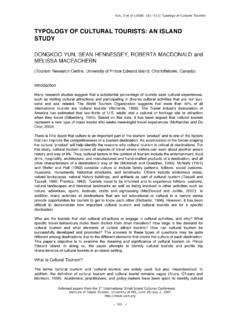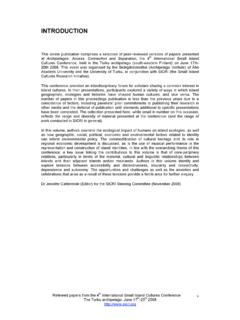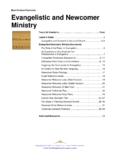Transcription of THE SILENT ECHOES OF CHATHAM ISLAND - SICRI …
1 Evans (2006:46-53) SILENT ECHOES Refereed Papers From The 2nd International Small ISLAND Cultures Conference, Museum Theatre, Norfolk ISLAND Museum, 9-13 February 2006. Edited by Henry Johnson 46 1 2 THE SILENT ECHOES OF CHATHAM 3 ISLAND 4 5 Mark Evans 6 7 (Macquarie University, Sydney, Australia) 8 9 Introduction 10 11 The fieldwork for this paper was originally designed to uncover the church music 12 practices and trends on CHATHAM ISLAND . As work progressed it became clear that the 13 research net needed to be cast more widely. Thus, the current musical culture of 14 CHATHAM ISLAND in general came into focus. Before reporting on my research on 15 CHATHAM ISLAND , I will provide some background to the current culture that can be found 16 there.
2 17 18 The CHATHAM Islands are part of New Zealand, yet are situated some 768 kilometres east 19 from Wellington and 749 kilometres from Napier. The CHATHAM Islands (44 S 176 W) 20 consist of two main inhabited islands: Pitt ISLAND (population c50) and CHATHAM ISLAND 21 (population c650). Pitt ISLAND lies 23 kilometres south east of CHATHAM ISLAND . There are 22 a further 23 islands contained within a radius of 50 kilometres, also considered to be 23 part of the CHATHAM Islands. 24 25 The original inhabitants of the CHATHAM Islands were the Moriori people, who are 26 thought to have landed on the islands from New Zealand between 700 and 1000 years 27 ago.
3 The Moriori people named the ISLAND Rekohu, which means misty ISLAND , and 28 although there is a growing body of research on the history and culture of the Moriori, 29 much remains to be discovered about their musical practices (see especially King, 30 2000). Accounts such as the following inform our piecemeal understanding of this 31 musical culture: 32 33 For amusements, the [Moriori] people had high-jumping .. and skipping with a 34 rope .. but no musical instruments, although they knew traditionally of the Koauau, or 35 flute of the Maoris, the use of which, however, was neglected. They had also Kapa, a 36 kind of dance, somewhat similar to the Maori haka, in which the people were arranged 37 in two parallel rows one behind the other.
4 And it was accompanied by a song. 38 (Shand, 1911:11) 39 40 Awareness of the CHATHAM Islands among Europeans occurred with Lieutenant William 41 Robert Broughton, commander of the ship the HMS CHATHAM , in 1791. Broughton 42 named CHATHAM after his ship, and Pitt ISLAND after William Pitt, the Earl of CHATHAM . 43 Evans (2006:46-53) SILENT ECHOES Refereed Papers From The 2nd International Small ISLAND Cultures Conference, Museum Theatre, Norfolk ISLAND Museum, 9-13 February 2006. Edited by Henry Johnson 47 Yet, rather than European colonisation, it was Maori invasion in 1835 that would 1 change the life of the Moriori forever.
5 Official records report that the Maori killed 226 2 Moriori most of these cannibalised as well although this number is probably over 3 300, when children are taken into account as well (King, 2000:63). The death toll 4 amounted to about one fifth of the Moriori population. Over one thousand further 5 Moriori subsequently died as a result of Maori aggression. The effects on Moriori 6 culture were catastrophic. 7 8 Early Christian Contact 9 10 The Chathams had their first exposure to Western Christianity in the mid 19th Century. 11 In 1840, a ship carrying three Anglican Maori students from a mission near Otaki 12 arrived.
6 They taught Maori people on the ISLAND to read and write. One of the Maori, 13 Wiremu Tamahana, preached at Waitangi for 25 years. Also, a Wesleyan minister, John 14 Aldred, sailed from Wellington with three Maori Wesleyan students in 1842. They 15 brought with them portions of the Bible written in Maori, which proved enormously 16 popular with local people (Holmes, 1993:148). 17 18 However, without doubt the most famous Christian contact came via the deployment of 19 German Lutheran missionaries to the ISLAND . ISLAND historian David Holmes wrote: 20 21 The five German missionaries to the Chathams were Johannes Engst, Johann Baucke, 22 Johann Muller, Franz Schiermeister and Oskar Beyer.
7 They were all members of the 23 Lutheran Gossener Mission in Berlin and belonged to the Moravian Brethen 24 sect.. [They arrived in 1843 and moved around a little before] they all ended up at Te 25 Whakaru, where they acquired a section and built two or three houses of schist stone 26 using burnt pipi shells for mortar .. the missionaries tried to preach to the Maori 27 people but with little success.. In 1845 the Berlin mission sent three women to be 28 wives for the missionaries. There were originally five women but two pulled out before 29 leaving Berlin [they arrived in 1846 and were married to 3 of the missionaries 8 days 30 later].
8 The missionaries and their wives all lived at Te Whakaru for a number of 31 years, after which events began to divide them .. Schiermeister went to Pitt ISLAND to 32 teach Frederick Hunt s children. He became very ill and was taken to Wellington by 33 Bishop Selwyn about 1855. Later he went to Brisbane as a Lutheran pastor.. Two 34 families on the Chathams today are descended from the Bauckes the Seymours and the 35 Prendevilles. (Holmes, 1993:148-150) 36 37 For all their ascetic fortitude, the German missionaries are most remembered today for 38 their farming. It is popularly accepted on the ISLAND that not one soul was saved through 39 their evangelistic efforts.
9 The circumstances of their mission remain most curious. What 40 pictures of their exceptionally constructed house do not reveal is that it was built in the 41 farthest north-west corner of the ISLAND . Furthermore, the house is hidden on the ocean 42 side of the steepest rise on the ISLAND . This is not a setting that would have attracted any 43 passing traffic at all. In fact, the walk into Waitangi in the 1850s would have taken a full 44 day, the best part of which would have been devoid of human contact. 45 46 47 Evans (2006:46-53) SILENT ECHOES Refereed Papers From The 2nd International Small ISLAND Cultures Conference, Museum Theatre, Norfolk ISLAND Museum, 9-13 February 2006.
10 Edited by Henry Johnson 48 Sounds of the Past 1 2 Interviews with long-term residents of the ISLAND , along with photographs from the 3 ISLAND s museum, reveal that the musical culture on the Chathams used to be very 4 different to that present today. Resident George Hough recalled playing in a band 5 during the 1950s and early 1960s, which featured saxophone, two guitars, accordion and 6 harmonica. He played accordion and harp, but could also play violin and guitar. The 7 band played for dances, or for anyone who wanted to have a sing (interview with the 8 author 6/12/05). During that time, there were many functions held in the community 9 hall, most of which would feature the band.






